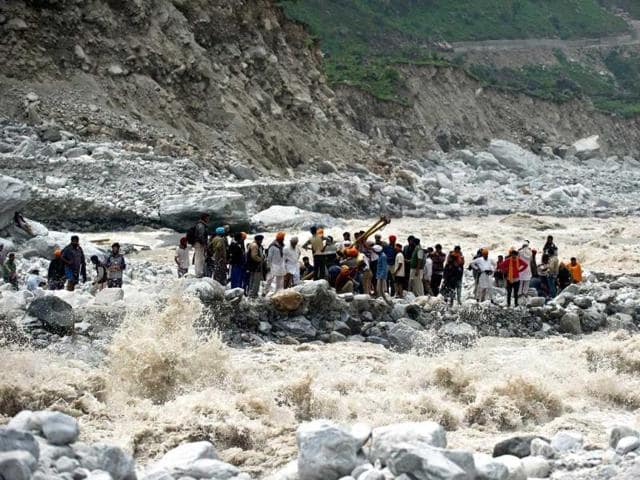Ticking time bomb: The catastrophe that awaits Uttarakhand
Public memory is short, the government’s memory’s shorter. Either it is this syndrome or hubris which has been making successive Indian governments so moon-eyed about building hydroelectric power projects (HEP) in seismically active Himalayan states, despite several warnings by experts.
Public memory is short, the government’s memory’s shorter.

Either it is this syndrome or hubris which has been making successive Indian governments so moon-eyed about building hydroelectric power projects (HEP) in seismically active Himalayan states, despite several warnings by experts.
Take, for example, Uttarakhand.
In the summer of 2013, a sudden cloudburst led to a devastating flash flood and landslides in the state, killing more than 5,700 people and destroying properties worth crores. After the disaster, several experts pointed out that the HEPs that were being built on the rivers in the state had aggravated the impact of the calamity.
Writing in the New Yorker on the recent Nepal quake — experts have warned that a similar one is in the offing in Uttarakhand — Isabel Hilton, CEO of chinadialogue, wrote on what happened at the construction site of the Rasuwagadhi hydropower dam on the Trishuli river when the quake struck: “…it triggered rockslides that cut the roads on both sides of the border. Aftershocks sent repeated showers of fresh rocks down onto rescuers on the Chinese side, who were trying to clear them”.
Hilton then described why it is risky to build dams in the Himalayan region: Once a quake hits a dam it “could send thousands of tons of water and rubble crashing downstream, piling horror upon catastrophe”.
A similar picture could emerge if a severe earthquake hits Uttarakhand.
SP Sati of the department of geology, HNB Garhwal University, Srinagar, told the Tribune recently: “Barring Tehri Dam, which is a rock and mud-filled structure, most of the hydropower dams in Uttarakhand are made up of reinforced concrete cement. The ability of these dams to withstand high-intensity tremors is highly questionable. They could collapse and lead to a large scale death and destruction downstream.”
HEPs involve deforestation, which increases the potential of erosion, landslides and floods. Blasting and the massive tunnelling also weaken the fragile mountains.
Geologists also argue that the risks of building dams in earthquake zones go well beyond an earthquake-induced collapse: Tremors trigger landslides that can block rivers or change their course, impacting the operation of a dam.
Uttarakhand falls in the central seismic gap region and the possibility of an earthquake of magnitude 8 cannot be ruled out in the state.
Scientists of the Jawaharlal Nehru Centre for Advanced Scientific Research, Bangalore, recently said that “Uttarakhand has the capability of hosting one”.
Despite such warnings and local opposition, Uttarakhand is building 450 HEPs.
Taking cognizance of the local protests against the HEPs, the Supreme Court in 2010 had asked for three kinds of assessments of the projects: Technical, biodiversity and social assessment: Only the first two have been done till now.
In 2010, the Comptroller and Auditor General of India submitted a report stating that project assessments, the distribution of the projects, the construction companies and even pre-feasibility studies had many flaws.
The GB Mukerjee task force’s report also wrote about the need for a separate development policy in the state.
In 2013, after the flash floods, the SC directed the ministry of environment and forests (MoEF) and Uttarakhand not to grant any further environment or forest clearances to hydroelectric projects in the state till further orders.
This stalled 96 proposed projects. It also directed the MoEF to appoint an expert body to study whether the existing and under-construction HEPs contributed to the disaster that struck the state, leading to the setting up of a high level panel under Ravi Chopra, director of the People’s Science Institute, a Dehradun-based advocacy group.
In its report, the panel pointed out to the specific evidence from the HEP construction sites and proved how each one escalated the disaster downstream.
It also agreed with a 2012 Wildlife Institute of India report which had concluded that the 24 dams in the Alaknanda and Bhagirathi River basins should be scrapped as they will cause irreversible harm to the biodiversity in Uttarakhand.
Two members of the panel (the Central Water Commission and Central Electricity Authority representatives) refused to accept the report and tabled a separate report stating the need for hydropower.
Since then much water has flowed under the bridge. In December 2014, the MoEF told the SC that HEPs had contributed to the 2013 disaster and no new power projects would be allowed without a comprehensive review and that would take a year.
But in January, the PMO asked the MoEF, the power ministry and Uttarakhand to present the “correct picture” before the court “regarding the critical need of the (hydroelectric) projects in Uttarakhand for green power and for livelihoods”.
But the minutes of the meeting do not mention the need for the comprehensive study that the environment ministry had so far advocated or putting on hold the dams till such a study was completed.
On April 13, the Centre told the SC that there is an inter-ministerial conflict on the issue and the highest authority — the PM — is out of office and that a decision would be taken once he was back.
This case on the future of HEPs — and the region will come up in the SC this week. The ruling will be crucial not only for the issues discussed here but also give us an insight into how public policies are made in India and what role empirical evidence plays in it.
kumkum.dasgupta@hindustantimes.com





